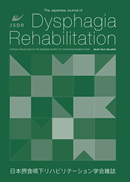Volume 4, Issue 2
The Japanese Journal of Dysphagia Rehabilitation
Displaying 1-8 of 8 articles from this issue
- |<
- <
- 1
- >
- >|
Review Article
-
2000Volume 4Issue 2 Pages 3-13
Published: December 30, 2000
Released on J-STAGE: June 24, 2020
Download PDF (5033K) -
2000Volume 4Issue 2 Pages 14-29
Published: December 30, 2000
Released on J-STAGE: June 24, 2020
Download PDF (5613K)
Original Paper
-
2000Volume 4Issue 2 Pages 30-37
Published: December 30, 2000
Released on J-STAGE: June 24, 2020
Download PDF (3293K) -
2000Volume 4Issue 2 Pages 38-46
Published: December 30, 2000
Released on J-STAGE: June 24, 2020
Download PDF (3911K)
Clinical Report
-
2000Volume 4Issue 2 Pages 47-54
Published: December 30, 2000
Released on J-STAGE: June 24, 2020
Download PDF (3326K) -
2000Volume 4Issue 2 Pages 55-63
Published: December 30, 2000
Released on J-STAGE: June 24, 2020
Download PDF (3756K) -
2000Volume 4Issue 2 Pages 64-68
Published: December 30, 2000
Released on J-STAGE: June 24, 2020
Download PDF (2225K) -
2000Volume 4Issue 2 Pages 69-77
Published: December 30, 2000
Released on J-STAGE: June 24, 2020
Download PDF (3419K)
- |<
- <
- 1
- >
- >|
